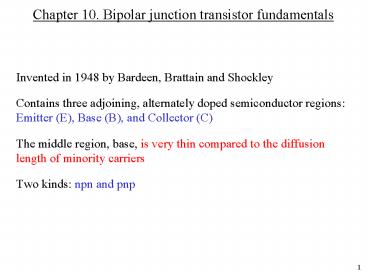Chapter 10' Bipolar junction transistor fundamentals - PowerPoint PPT Presentation
1 / 14
Title:
Chapter 10' Bipolar junction transistor fundamentals
Description:
BJT circuit symbols. As shown, the currents are positive quantities when the ... 1 = hole current lost due to recombination in base, IBR ... – PowerPoint PPT presentation
Number of Views:143
Avg rating:3.0/5.0
Title: Chapter 10' Bipolar junction transistor fundamentals
1
Chapter 10. Bipolar junction transistor
fundamentals
- Invented in 1948 by Bardeen, Brattain and
Shockley - Contains three adjoining, alternately doped
semiconductor regions Emitter (E), Base (B), and
Collector (C) - The middle region, base, is very thin compared to
the diffusion length of minority carriers - Two kinds npn and pnp
2
Schematic representation of pnp and npn BJTs
Emitter is heavily doped compared to collector.
So, emitter and collector are not
interchangeable. The base width is small
compared to the minority carrier diffusion
length. If the base is much larger, then this
will behave like back-to-back diodes.
3
BJT circuit symbols
IE IB IC and VEB VBC VCE 0 VCE ?
VEC
As shown, the currents are positive quantities
when the transistor is operated in forward
active mode.
4
BJT circuit configurations and output
characteristics
5
BJT biasing modes
6
Cross sections and simplified models of discrete
and IC npn BJTs
7
Electrostatic variables for a pnp BJT at
equilibrium
8
Qualitative discussions of operation
Consider two diodes, one forward biased and one
reverse biased.
reverse
forward
9
Qualitative discussion of transistor action
Combine the two diodes!
VF
VR
No transistor action
10
Consider very thin base width Transistor action
Hole concentration is zero here, reverse biased
VF
VR
The collector current IC is almost equal to IE,
and collector current is controlled by the E-B
junction bias. The loss, i.e. ? lt 1 corresponds
to the recombination of holes in base.
11
PNP under forward active mode
IE IEP IEN 1 2 5 IB IBR IBE IBR
IEN (4 5) IC IEP IBR 2
12
Current components
1 hole current lost due to recombination in
base, IBR 2 hole current collected by
collector, IC 1 2 hole part of emitter
current, IEP 5 electrons injected across
forward biased E-B junction, ( IBE) same
as electron part of emitter current, IEN 4
electron supplied by base contact for
recombination with holes lost, IBR ( 1) 3
thermally generated e h making up reverse
saturation current of reverse biased C-B
junction. (generally neglected)
13
Performance parameters (Consider pnp)
Neglect the reverse leakage (electron) current of
C-B junction
Emitter efficiency
Fraction of emitter current carried by holes. We
want ? close to 1.
Base transport factor
Fraction of holes collected by the collector. We
want ?T close to 1.
Common base dc current gain
?Note that ?? is less than 1.0 but close to 1.0
(e.g. ? 0.99)
14
Performance parameters (Consider pnp)
Common emitter dc current gain, ?dc
But,
?Note that ? is large (e.g. ? 100)
For npn transistor, similar analysis can be
carried out. However, the emitter current is
mainly carried by electrons.
Example































